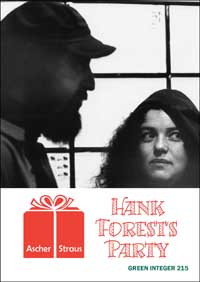By Mary Burger
Hank Forest’s Party is the latest volume of a collaborative project, part novel, part memoir, part philosophy, written by Sheila Ascher and Dennis Straus and published under the name Ascher/Straus. The ongoing project Monica’s Chronicle, begun in the 1970s, is a narrative of the process of narration. Narrator Monica records experiences of everyday life in a neighborhood in Rockaway Park, Queens, and weaves her notes through reflections and reinterpretations about the connections between experience, memory, and writing.
The framing event in Hank Forest’s Party is the birthday of a little boy on Monica’s block. The party overlaps with Monica’s efforts to remember and write about it:
Monica enters Grete and Andy’s new apartment, looks around memorizing. Carries this overly-fresh memory like a bright basin of water that’s going to slosh and spill with every step. Keeps spilling throughout the day, till she gets home. Already in Grete and Andy’s apartment she’s wondering if there will be anything left to pour out at her desk, where writing replaces memory.
The question of how experiences become stories is a constant through line:
Thinking at the party (as if already not at the party) or at home later (as if still at the party) Monica wonders why one story chooses us and not another. Many-many-too-many stories are always buzzing about, but only one buzzes up and bites us.
The time and space of the story spill far beyond the party into the extended lives of the block’s residents. Monica relays intimate back stories and day-to-day details that stack and overlap like the close-quartered living spaces of the block itself. She knows her neighbors’ private hopes and disappointments, as if privy to their inner monologues:
Marriage to Andy Forest changed nothing. Very disappointing to Grete. Had assumed, without thinking much about it, that marriage to Andy Forest would change the balance of life in this house, but it didn’t.
Other neighbors literally walk into Monica’s narrative as she records the day’s events from her front porch:
Pat Corcoran steps out of her front door through Monica’s writing and says that Philip passed his exam and is already working: an apprentice splicer, on his way toward becoming a full-time splicer and hopefully even a master splicer like his father, John.
But that’s not what she wants to talk about, she says. Something is bothering her and she has to talk about it.
Despite the story’s inquisitive and intimate tone, we never learn much about Monica herself. She explores her ideas through the material of others’ lives—a filmmaker who never comes out from behind the camera. Some of the detachment comes through the accumulation of time—Hank Forest’s Party was written 25 years after the framing events. Periodically the story is preoccupied with what was left out or lost from the first notes:
Monica’s notes say: “at her desk in the red room”: but now, twenty-five years later, she doesn’t remember (and doesn’t see how there could have been space for) a desk in the red room.
Events circle back to Hank’s party, even as years pass, couples split up or move away, and Hank himself is no longer a little boy. By the end, Monica seems no more certain about the nature of storytelling, though no less energized to keep interrogating it:
True or false: what’s remembered is an impediment in the stream of what-doesn’t-want-to-be-remembered. What-doesn’t-want-to-be-remembered seeks forgetfulness by flowing as rapidly as it can around and through memory’s rusting chassis where, twenty-plus years ago, it tore up railing and embankment and landed in the river just where it makes a beautiful bend out of town.
Ascher/Straus’ partnership is unique as far as I’m aware, both in its scope and its hybrid story-interrogation form. An earlier volume, ABC Street (2002) also derives from Monica’s Chronicle. Thousands of words of the original notes for the Chronicle are posted on the writers’ website, http://www.ascher-straus.com/. Their work also includes a series of “space novels,” interactive public events in the 1970s and 1980s that created temporary, spatially-bound narratives.
Their project in its entirety is an invitation and a challenge to anyone setting out to redefine narrative writing. I recommend Hank Forest’s Party, and all of Ascher/Straus’ long collaboration, as a primer on the elusive pursuit of memory and words.
Hank Forest’s Party
By Ascher/Straus
Green Integer (2014)
ISBN: 978-193338-247-0










